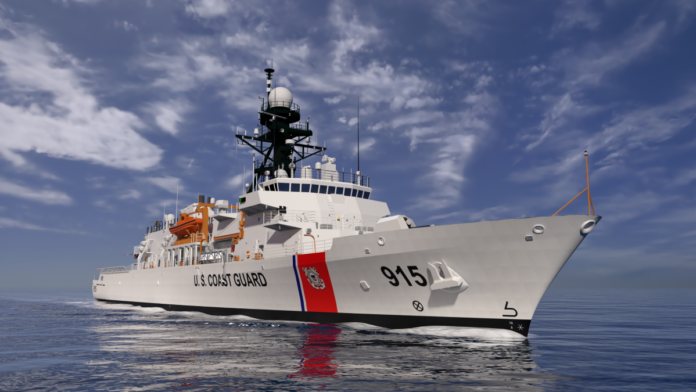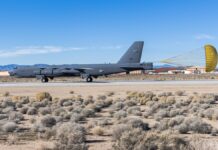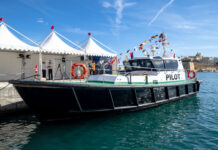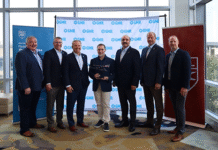The Coast Guard christened the first offshore patrol cutter (OPC), Argus, on Oct. 27 at Eastern Shipbuilding’s Nelson Shipyard in Panama City, Florida. Following the christening event, Eastern Shipbuilding launched the cutter into the water for the first time.
Adm. Linda Fagan, Coast Guard commandant, described the OPC as a “game-changer for the Coast Guard and for the nation” in her keynote address. Fagan added, “Demand for Coast Guard missions – and cutters that execute them – has never been higher and that demand is global, and this ship will contribute to helping ensure maritime governance and sovereignty across the world.”
Retired Capt. Beverly Kelley, the first woman to command a U.S. military vessel, christens Argus. Watching the ceremony are (from left): Rear Adm. Chad L. Jacoby, assistant commandant for acquisition and chief acquisition officer; Adm. Linda Fagan, Coast Guard commandant; and Capt. Tobias Reed, prospective commanding officer of Coast Guard Cutter Argus. U.S. Coast Guard photo by Petty Officer 2nd Class Ronald Hodges.
The ship’s sponsor is retired Capt. Beverly Kelley, the first woman to command a U.S. military vessel. The cutter is named for the Revenue Cutter Argus, one of the first 10 ships assigned to the U.S. Revenue Cutter Service, one of the predecessor agencies that merged to form the modern Coast Guard. The original Argus entered service in 1791, two years after the signing of the U.S. Constitution.
The Coast Guard considers the OPC program one of the service’s highest acquisition priorities, stating that it is the best way to fill the service’s need for long-term offshore capability to maintain effective current and future missions. It will replace the existing medium endurance cutters, which are becoming increasingly expensive to maintain and operate. The OPC will provide a capability bridge between the national security cutter, which patrols the open ocean in the most demanding maritime environments, and the fast response cutter, which serves closer to shore.
The OPCs will conduct missions including law enforcement, drug and migrant interdiction, search and rescue, and other homeland security and defense operations. Each OPC will be capable of deploying independently or as part of task groups, serving as a mobile command and control platform for surge operations such as hurricane response, mass migration incidents and other events. The cutters will also support Arctic objectives by helping regulate and protect emerging commerce and energy exploration in Alaska.













